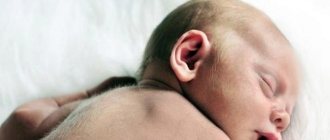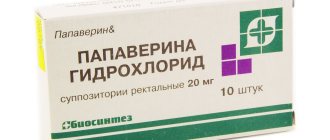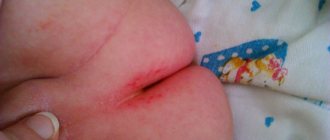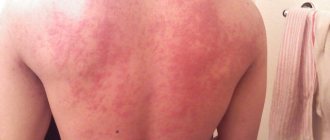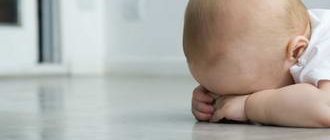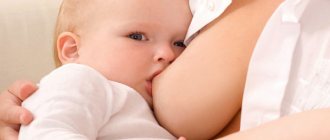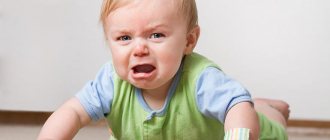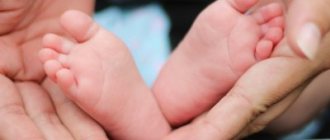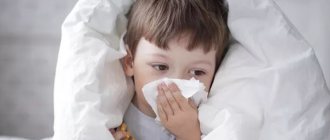Hair on a man's back is a fairly common occurrence, but sometimes a similar problem occurs in women and even children. Some men are comfortable with excessive hairiness, while others, on the contrary, develop complexes because of it.
This is especially true for women, since for them this phenomenon is considered unnatural. In order to successfully fight it, first of all, it is necessary to find out the causes of hair on the back in men, women, and also in children, because there are several of them, and, by the way, one of them has roots since ancient times.
Back hair is more natural for men, but for women it is a pathology.
Why does excess hair appear on the back?
Heredity
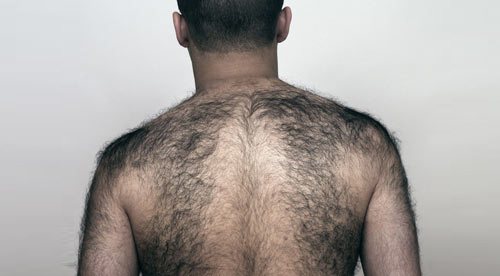
Photo of a hairy back, the cause of which is a hereditary factor.
Science to this day cannot give a definite answer why it is often the male sex who grows hair in the back area. It is believed that this is a hereditary factor that dates back to the times when people were like monkeys. In other words, faced with such a problem, the strong half of humanity still feels the echoes of evolution.
This fact is proven by the fact that parents often observe hairs on the back of a newborn, especially if he was born prematurely. It turns out that they are formed in the womb at 3-4 months of pregnancy. At this moment, the baby’s body is covered with thick embryonic hairs.
Newborn baby with fluff on his back.
Closer to childbirth, they seem to disappear, and instead of them a short, soft, barely noticeable fluff is formed. However, this does not always happen, and the baby may be born with a lot of hair, which is usually located on the back, shoulders, ears and forehead. These hairs are called lanugo.
As a rule, the embryonic covering disappears in babies on its own, but many inexperienced mothers immediately run to their friends with the question of how to roll out such hairs in order to remove them, worrying that this will not happen spontaneously.
Yes, in Rus' there were beliefs that this should be done with your own hands in a bathhouse with a crumb of bread dipped in breast milk. However, according to many doctors, rolling out the cannon in babies is just a superstition, since nothing like this has been described anywhere in medicine.
Note! The fact that hairs on the back of a newborn are not a pathology is a proven fact.
Hairy back as a symptom of disease
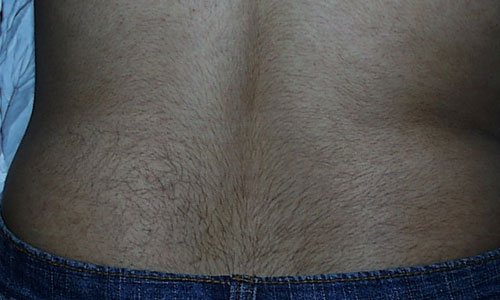
Hirsutism in a woman, which affects the back area.
In addition to the hereditary factor, another, more serious cause of excessive back hair is a disease such as hirsutism, in which there are hormonal disorders in the body. In particular, this disease is due to the fact that the concentration of testosterone (male hormone) in the blood increases.
For men, this is a natural phenomenon, so this disease occurs only in women. For them, such a failure is dangerous because it can cause a lot of health problems.
Therefore, if long and coarse hair is found on the back of a girl or woman, then you should definitely contact an endocrinologist who knows what studies are necessary to make an accurate diagnosis. Moreover, diagnosis should not be delayed, since this disease is often accompanied by infertility, and the sooner it is detected, the more effective and quicker the treatment will be.
There is another disease called hypertrichosis, one of the symptoms of which is coarse hair on the back, as well as on other parts of the body, and it can be completely covered with such vegetation. Unlike the previous disease, it can affect not only women, but also men.
A girl with congenital hypertrichosis, which affects most of the body.
That is, hypertrichosis affects people regardless of gender.
Its etiology may be due to many factors:
- congenital mutation;
- nervous stress;
- oncology;
- traumatic brain injuries;
- long-term use of hormonal medications;
- malfunctions of the secretory glands (pituitary gland, ovaries, adrenal glands);
- thyroid dysfunction;
- menopause
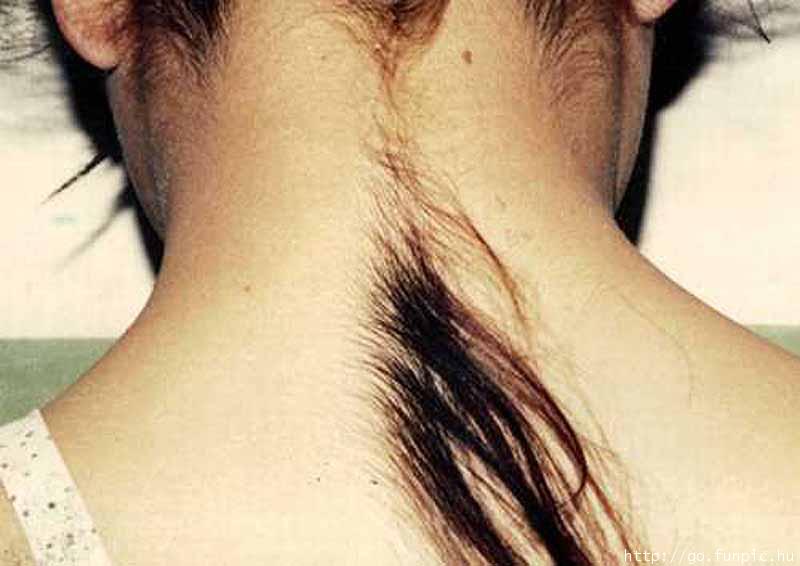
Hypertrichosis, in which hairiness is present only on the upper back.
With congenital hypertrichosis, it is only necessary to remove hair, since this form is incurable. And in what ways in this, as well as in other situations, this can be done, we’ll talk further.
Should you worry: two views on the appearance of bristles in a baby
The very idea that hard black stubble may appear on the body of a little baby can frighten any mother. What is this? Genetic disorder? A special type of damage? Or a signal of some internal disease? Finding dark thickened hair on the back or other parts of the body in newborns can be quite difficult to contain panic.
In fact, the attitude of mothers to this problem fully corresponds to the meaning of the saying “Fear has big eyes.” I hasten to reassure you and cite two important, in my opinion, facts.
- Firstly, official medicine does not recognize the diagnosis of “bristles in babies” at all;
- And secondly, even among the descriptions of this phenomenon in folk recipes it is noted that it does not pose any threat to the baby’s health and is quite easy to treat.
If your child is restless...
The presence of hairs should not bother the child. But if he is anxious for no reason, cries, arching his back, sleeps poorly, you should find out whether the hair on the newborn’s back is the cause of discomfort. Clothing fibers can stick to the hairs and curl into clumps, which can cause discomfort for the baby.
Sometimes parents are given advice on how to remove so-called bristles using dough, bread crumbs or honey. This procedure involves rolling out hairs and can be painful for the child. Such actions can cause irritation and even inflammation of the delicate skin of a newborn.
To rid a child of lanugo, you need to adhere to strict hygiene rules and follow certain procedures. The newborn should be bathed regularly, gently massaging the back with a soft sponge. After bathing, the areas where lumps accumulate are lubricated with baby cream. After some time, the hair on the newborn's back will soften and can be carefully removed with a cotton swab. The rapid thinning and disappearance of hair on the back of a newborn is facilitated by his activity. Parents should stimulate it by turning the child from side to side, from back to stomach.
How to remove using folk remedies
Traditional medicine does not define stubble on a baby’s body as a disease that requires treatment. Then, parents turn to folk methods and remedies for help.
Note! Before using a folk remedy, you should make sure that it will not harm the baby’s health.
It is advisable not to resort to extreme methods and means. At home, treatment can negatively affect the condition of the baby’s skin.
Remove with folk remedies:
| Folk method | How to withdraw |
| Roll out the bristles with yeast dough | Knead yeast dough based on milk and honey. After bathing, roll out the problem area with dough for 10 minutes a day. Complete healing will require 8 sessions |
| Wrapping with black bread | A thin flat cake is formed from the crumb of black bread. Breast milk is used to soften bread. Place the cake on the problem area and wrap the area in a diaper. Bathe the baby and then remove the crumb |
| Night compress | Steam the baby in a bathhouse, spread the body with rich cream and wrap it in a piece of gauze. Leave the material overnight and carefully remove it in the morning. Treat the skin with body lotion or baby cream |
What is lanugo?
Lanugo begins to appear on the skin of the fetus at 12 weeks of intrauterine development. The growing body secretes waxy substances that are designed to protect the baby’s body, and the fluff retains them, preventing them from going into the amniotic fluid. Fine hairs have a short lifespan; they fall out and new ones grow in their place. By the end of gestation, the fluff, as a rule, disappears, and waxy substances completely cover the baby's skin. This lubricant on the body will not only protect the newborn from bacteria and new temperature conditions, but will also facilitate its passage through the birth canal.
But lanugo does not always disappear before the baby is born. When a baby is born prematurely, the fluff does not have time to fall out completely, and hair on the baby’s body is visible to the naked eye in places not intended for this. Lanugo covers the newborn's shoulders and back, ears and forehead. Thin hair on these areas of the baby's body frightens young parents who do not know the reason for the appearance of this fuzz and whether it is a sign of developmental abnormalities.
Theoretical causes of the condition
Experts have not yet identified the factors that provoke the “poker”, but there are several guesses on this matter:
- Some consider the formation of stubble in a newborn to be a consequence of the rolling off of dead skin cells of the epidermis, secretions of the sebaceous glands and remnants of vellus hair. This may indicate poor quality care for the baby. According to most pediatricians, tickler appears as a result of neglect of basic hygiene rules and is the most common dirt.
- Others refer to such hairs as atavisms (residual formations inherited from distant ancestors).
Regardless of what caused the condition, formations can be removed from the surface of the skin of children using the most common hygiene procedures. During regular bathing of the child, problem areas should be gently rubbed with a soft mitten with a large amount of foam from baby shampoo.
Symptoms
When a newborn has a lot of hair on his back, it can lead to unpleasant consequences. Due to the imperfect structure of the skin surface and its tendency to expand pores, a phenomenon such as “Poker” may develop. The structure of the surface of the baby's skin resembles that of a pig, with a dark dot. This condition is accompanied by symptoms:
- increased irritability, moodiness;
- frequent sleep interruptions;
- we cry when the injured skin touches the surface;
- lethargy, loss of appetite.
The filling of pores occurs due to the accumulation of sebaceous gland secretions mixed with dead skin particles and lanugo hairs.
Pediatricians' opinion
The presence of stubble in a newborn or one-month-old baby is in no way considered a pathology or abnormality.
Any doctor will confirm this. Experts say that the appearance of coarse hair in some children is a manifestation of evolution.
Komarovsky claims that this manifestation of hair growth on the baby’s body does not require attention at all - over time, the discomfort will disappear, but for now the baby can sleep on his tummy.
General recommendations from pediatricians:
- Check the general health of the baby.
- Reduce contact of the problem area with other surfaces.
- Monitor the condition of the stubble.
There is no need to treat stubble. It is impossible to get rid of the problem using radical methods within the framework of medicine.
What removal methods are there?
Traditional medicine today does not recognize the problem of stubble, and manufacturers do not produce specialized products for removing coarse hair. Leading pediatricians say that over time, the problem of a child's restless behavior will go away.
In practice, parents are faced with the fact that children do not know how to tolerate and react sharply with their behavior to any unpleasant influence. In such a situation, traditional medicine comes to the rescue, capable of alleviating the baby’s condition and relieving him of the root cause of discomfort in the form of hard stubble. The most common treatment is the following folk remedies:
- rolling out bread;
- removal with honey.
The advantage of folk remedies is absolute safety for the newborn, effectiveness and rapid onset of the effect of alleviating the baby’s well-being. There is no scientific confirmation of such methods, but the practical experience of mothers is proof of their effectiveness. They do not require the purchase of expensive ingredients and simple means available in everyday life are enough to carry out the procedure.
The experience of our grandmothers
We will find a completely different attitude towards the appearance of bristles in a newborn in folk medicine. Our grandmothers believe that hard hairs bother the baby quite a lot, interfere with his sleep, and cause pain when he lies on his back. Read about the real reasons for poor sleep in the article why a newborn does not sleep well>>>.
It is clear that it would be in vain for grandmothers to talk about such a problem, because they are our first assistants and advisers in caring for the baby. Therefore, you need to listen more closely to their words and recommendations.
First of all, popular beliefs say that finding bristles on a newborn is not very easy. Because they grow under the skin and, without coming to the surface, begin to curl up. Perhaps it is precisely because of this appearance of the bristles that healers call this disease “poker in newborns.”
Sometimes the bristles are noticed simply by running your hand over your child's skin. But most often it is not possible to determine the appearance of hard hairs by touch. The main indicator that can prompt you to look for a “poker” on the baby’s body is his restless behavior while in a lying position.
Usually mothers say that the child is calm while being carried in their arms and begins to scream loudly and arch his back if you try to put him on a table or in a crib. Of course, many can say that in this way the baby is simply capricious and demands attention, does not want to be let off the hook. This is discussed in the article: How to wean a child off your hands?>>>
However, experienced mothers, having observed such behavior of the baby, still start talking about the possible appearance of bristles. And then you will hear from them the following tips on how to identify bristles in a newborn:
- For some reason, the main ingredient in this matter is breast milk. After bathing, you are advised to sprinkle a few drops of milk on your baby's body and begin to gently rub it into the skin. Interesting article on the topic: how to bathe a newborn baby>>>
- This procedure should be carried out for approximately 5 – 7 minutes;
- And then, according to eyewitnesses, right before our eyes, coarse hairs will begin to appear from under the skin.
It’s quite difficult to imagine this process and, to be honest, I don’t really believe that this is exactly how everything happens. But popular rumor does not arise out of nowhere, which means we will actually see something like this.
In general, there is no particular clarity in the reasons and process of bristle germination. Moreover, folk healers do not try to explain these issues in detail, but claim that all this can manifest itself in newborns if their mothers kicked cats or ate lard with skin during pregnancy.
That is why the stories about the “baby’s poker” look a little dubious, but it is still possible to carry out the proposed test. There will definitely be no harm to a newborn’s skin from a massage using mother’s milk.
Opinion of medical specialists
Pediatricians reject the possibility of such a disease in a child as a poker. But even they cannot help but admit that sometimes children in the first month of life experience strange formations on the skin.
Doctors explain this by saying that newborns exhibit adaptation erythema caused by temperature changes - redness of the skin. A few days after birth, the redness will go away, and in its place a crust of dead epithelial cells and shed vellus hair will form. Young parents mistake these formations for bristles.
The crust will fall off on its own with proper child hygiene. The baby's skin should be regularly steamed in warm water, and then lubricated with baby cream.
Sometimes the baby's mother may mistake rolled lanugo for bristles when the baby sweats or stays in one position for a long time. Simple regular hygiene can help in this situation.
Treatment methods for tumors on the coccyx
A fistula on the coccyx looks like a narrow tube that opens into holes on the surface of the skin. In some cases, the inflammatory process starts; it can be provoked by:
- injuries;
- infectious diseases;
- hypothermia.
Inflammatory phenomena gradually make the course wider, and then begin to destroy it. Neighboring tissues are affected, and another fistula may appear, but in a different location. If you treat this disease incorrectly, namely, do not rush to the doctor, but try to get rid of this problem on your own, there is a high probability of the following complications:
- another fistula appears, and sometimes more than one;
- a recurrent abscess develops;
- phlegmon develops.
These are already more serious problems than a bruise after an excision operation. It is also worth remembering that the risk of complications is reduced if surgery is performed as early as possible. Usually, with intervention in childhood, recovery occurs quickly, and the child is discharged after a few days.
The operation itself to remove the ECX is not complicated, but it is advisable to do it in a specialized institution rather than in conventional surgery. Since there are specific features of the anatomical structure of this area and it is necessary to take into account the nature of the course of the disease.
Sources:
- Clinical guidelines for the diagnosis and treatment of adult patients with epithelial coccygeal duct. Association of Coloproctologists of Russia.
- Surgical treatment of the epithelial coccygeal tract: clinical and anatomical aspects. – A.I. Zhdanov, S.V. Krivonosov, S.G. Brezhnev.
- Gastrointestinal tract No. 1, 1, 2020 – Epithelial coccygeal tract and sacrococcygeal suppuration. – V.L. Rivkin, ZAO Center for Endosurgery and Lithotripsy, Moscow.
What causes stubble in a newborn?
Worried parents usually have a question about where the hard hair brush on the little body of the baby came from.
Is it possible to remove coarse hair tufts? It is worth first finding out the reason, and then talking about further actions.
What happens from:
- A few months after birth, the cause of hair loss may become coarser.
- The cessation of hair formation in the womb, which is due to the normal evolutionary development of the baby.
- Problems with the functioning of the pores or sebaceous glands in areas of the skin that most often come into contact with other surfaces.
The first two cases are the most common and do not cause discomfort to the baby. The latter indicates violations.
Note! Usually, already in the maternity hospital, specialists identify stubble and determine the cause of its origin.
Any of the options can occur at any stage of the baby’s growth. Only a pediatrician can give a more precise definition.
Why does a child grow hair on his back?
Many babies are born with lanugo hairs, which develop from the time they are in the womb, from the twelfth week. Gradually the hairs die off, but are replaced by others.
The hairs gradually become thinner and less noticeable. For this reason, lanugo cannot pose a danger, because the main task is to protect delicate skin. Initially, the hairs retain a special substance secreted by the baby’s body and allow it to successfully develop in the womb.
At the same time, hair on a baby's back may appear after birth. Is this situation the basis for strong feelings? Before answering this question, it is important to understand why a baby may grow hair on his back after birth.
Reasons for hair growth on the back of infants:
- if a newborn is born with a large number of hairs on the back and other parts of the body, one can suspect the influence of heredity and the predominance of the hormone testosterone, which is responsible for such processes;
- The causes of abnormalities in hair development can only be determined by a doctor after an examination. To date, medicine has not identified specific causes for such deviations;
- premature birth of a baby. If the baby is not full term, the lanugo hairs have not completely fallen out;
- pathology. We can talk about this reason only if the hairs persist several months after the birth of the baby. Under such circumstances, you should consult a doctor who can diagnose and prescribe an effective course of treatment.
Vellus hair on the body of a newborn is not a typical disease, despite the fact that the baby can experience discomfort and pain.
How does vellus hair develop in a newborn? After the birth of a child, redness of the delicate skin is expected to appear, and this process is usually called physiological erythema. After a couple of months, the phenomenon goes away, but it is replaced by peeling of the skin, after which small hairs are discovered.
Such hair on the body of a newborn is vellus, but it can be felt if you stroke the baby’s delicate body.
Why does she appear?
Where and why does the “poker” appear in a baby? It turns out that it grows on the body and even on the baby’s face when he is still in the womb, but if development proceeds normally, then after 36 weeks these small hairs are lost. In rare cases, they do not fall out and become a so-called atavism. According to Darwin's theory of human origins, people had hair all over their bodies, but only partially remained in the course of evolution. The bristles that remain on some newborn children in our time are as atavistic an element as the coccyx or appendix.
READ ALSO: what is scrofula and for what reasons does it occur in children?
It turns out that there is nothing abnormal or dangerous in this phenomenon; one could safely ignore it if it did not cause the baby so much inconvenience, and often even acute pain. That is why there was a need to invent ways to get rid of unnecessary coarse hair that grows completely pointlessly.
